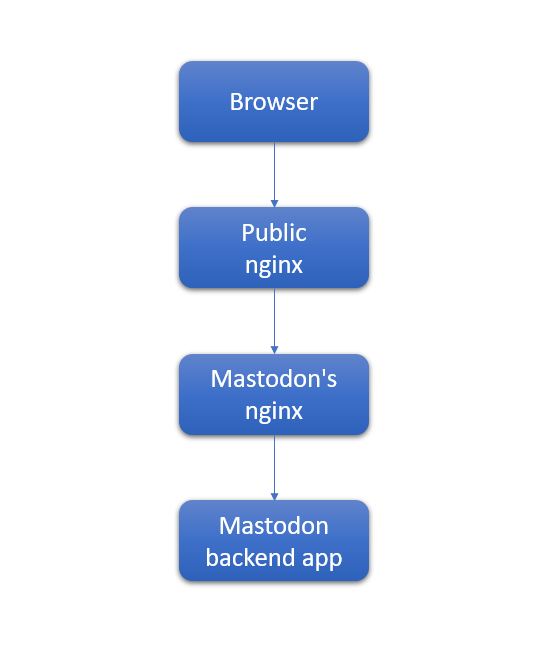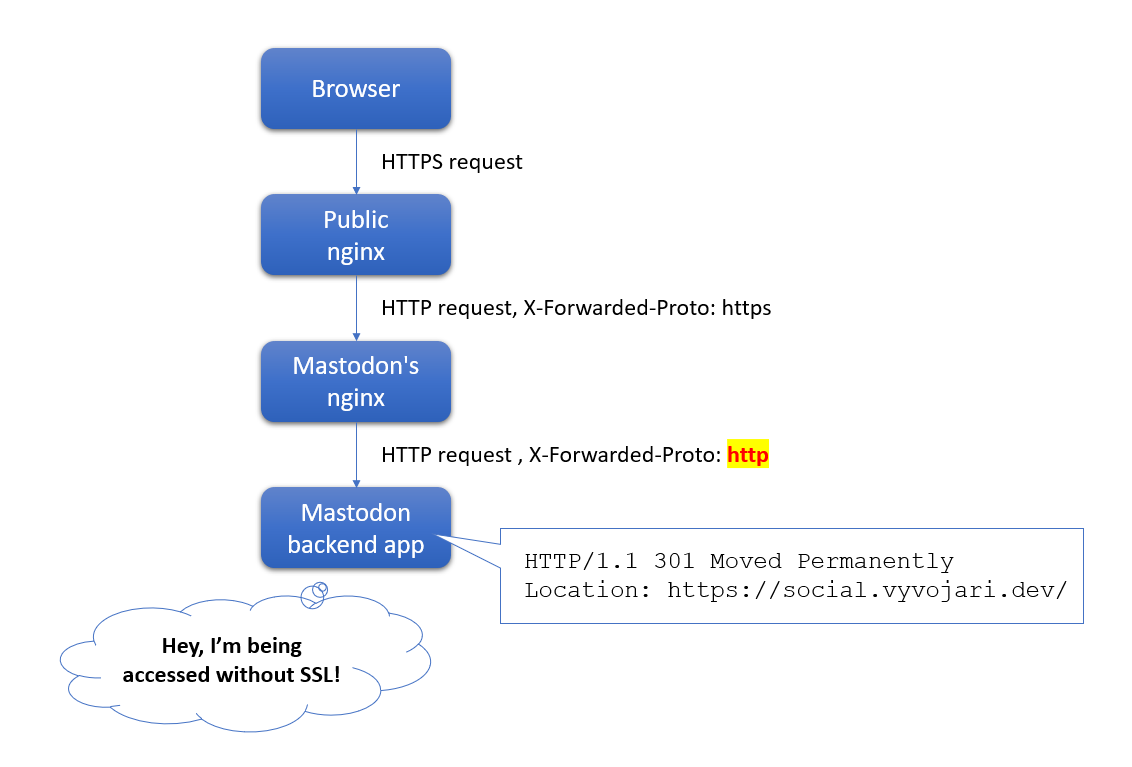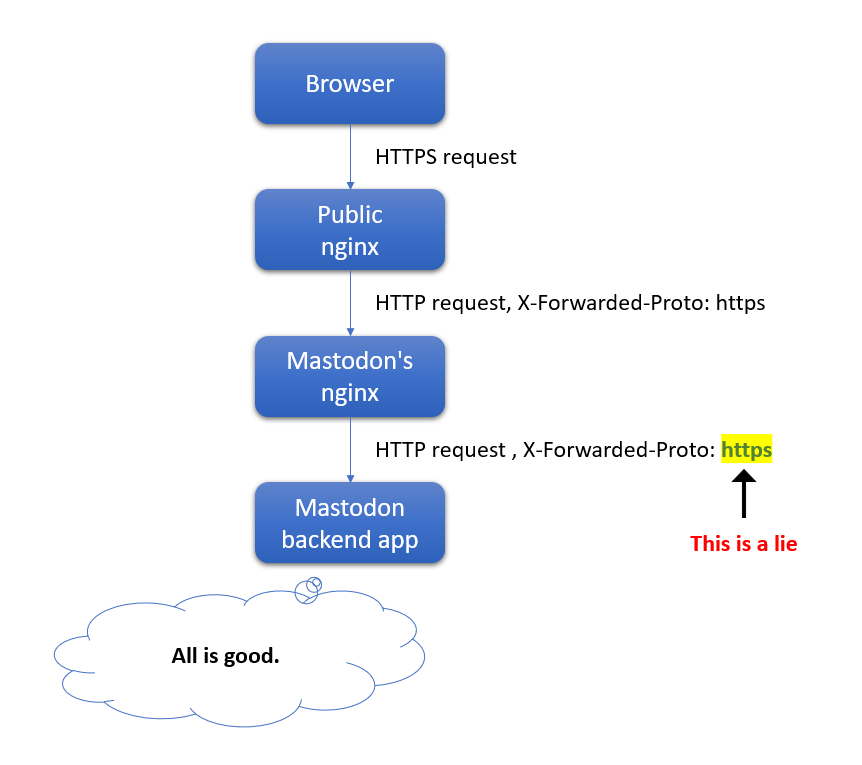How to run a Mastodon instance behind a reverse proxy

Recently, I needed to deploy a Mastodon instance that was being run behind a reverse proxy.
The infrastructure was already hosting other web-facing applications: a blog (Ghost) and a discussion forum (Discourse). Yes, it was meant for this platform (vyvojari.dev).
To keep the different pieces of software isolated, I decided to deploy Mastodon in an LXC container and proxy the requests from the main Nginx to the Mastodon-specific Nginx in the LXC container.

It turned out that the largest challenge was to have the Mastodon instance work without SSL.
Mastodon doesn't support running without HTTPS, as some web functionality doesn't work over plain HTTP anymore: https://discourse.joinmastodon.org/t/mastodon-on-http-no-https/3020/2 .
However, even though the reverse proxy does the HTTPS termination, so the whole thing is being served with SSL, the application does a 301 redirect to the HTTPS version unless it receives the request via HTTPS (actually, unless its webserver (Nginx) tells it that the request was received using HTTPS).

The solution was to lie to Mastodon and tell it that the request was received using the HTTPS scheme, even though the request from the reverse proxy was received using plain HTTP.

The reverse proxy configuration is pretty standard stuff. Simple reverse proxy with SSL termination:
server {
listen 80;
listen [::]:80;
server_name social.vyvojari.dev;
location / { return 301 https://$host$request_uri; }
}
server {
location / {
proxy_pass http://127.0.0.1:8080; # this is the LXC port 80 (Mastodon's nginx) proxied to the host machine port 8080
proxy_set_header Host $host;
proxy_set_header X-Forwarded-Proto $scheme;
proxy_set_header X-Real-IP $remote_addr;
proxy_set_header X-Forwarded-For $proxy_add_x_forwarded_for;
}
listen [::]:443 ssl; # managed by Certbot
listen 443 ssl; # managed by Certbot
server_name social.vyvojari.dev;
ssl_certificate /etc/letsencrypt/live/social.vyvojari.dev/fullchain.pem; # managed by Certbot
ssl_certificate_key /etc/letsencrypt/live/social.vyvojari.dev/privkey.pem; # managed by Certbot
include /etc/letsencrypt/options-ssl-nginx.conf; # managed by Certbot
ssl_dhparam /etc/letsencrypt/ssl-dhparams.pem; # managed by Certbot
}
Mastodon's Nginx configuration needed to be changed to the following.
The important bits are:
- there is no SSL-enabled server,
- the
location @proxysendsX-Forwarded-Proto: httpseven though the received request use HTTP scheme.
map $http_upgrade $connection_upgrade {
default upgrade;
'' close;
}
upstream backend {
server 127.0.0.1:3000 fail_timeout=0;
}
upstream streaming {
server 127.0.0.1:4000 fail_timeout=0;
}
proxy_cache_path /var/cache/nginx levels=1:2 keys_zone=CACHE:10m inactive=7d max_size=1g;
server { # listen only on plain HTTP
listen 80;
listen [::]:80;
server_name social.vyvojari.dev;
keepalive_timeout 70;
sendfile on;
client_max_body_size 80m;
root /home/mastodon/live/public;
gzip on;
gzip_disable "msie6";
gzip_vary on;
gzip_proxied any;
gzip_comp_level 6;
gzip_buffers 16 8k;
gzip_http_version 1.1;
gzip_types text/plain text/css application/json application/javascript text/xml application/xml application/xml+rss text/javascript image/svg+xml image/x-icon;
location / {
try_files $uri @proxy;
}
# If Docker is used for deployment and Rails serves static files,
# then needed must replace line `try_files $uri =404;` with `try_files $uri @proxy;`.
location = /sw.js {
add_header Cache-Control "public, max-age=604800, must-revalidate";
add_header Strict-Transport-Security "max-age=63072000; includeSubDomains";
try_files $uri =404;
}
location ~ ^/assets/ {
add_header Cache-Control "public, max-age=2419200, must-revalidate";
add_header Strict-Transport-Security "max-age=63072000; includeSubDomains";
try_files $uri =404;
}
location ~ ^/avatars/ {
add_header Cache-Control "public, max-age=2419200, must-revalidate";
add_header Strict-Transport-Security "max-age=63072000; includeSubDomains";
try_files $uri =404;
}
location ~ ^/emoji/ {
add_header Cache-Control "public, max-age=2419200, must-revalidate";
add_header Strict-Transport-Security "max-age=63072000; includeSubDomains";
try_files $uri =404;
}
location ~ ^/headers/ {
add_header Cache-Control "public, max-age=2419200, must-revalidate";
add_header Strict-Transport-Security "max-age=63072000; includeSubDomains";
try_files $uri =404;
}
location ~ ^/packs/ {
add_header Cache-Control "public, max-age=2419200, must-revalidate";
add_header Strict-Transport-Security "max-age=63072000; includeSubDomains";
try_files $uri =404;
}
location ~ ^/shortcuts/ {
add_header Cache-Control "public, max-age=2419200, must-revalidate";
add_header Strict-Transport-Security "max-age=63072000; includeSubDomains";
try_files $uri =404;
}
location ~ ^/sounds/ {
add_header Cache-Control "public, max-age=2419200, must-revalidate";
add_header Strict-Transport-Security "max-age=63072000; includeSubDomains";
try_files $uri =404;
}
location ~ ^/system/ {
add_header Cache-Control "public, max-age=2419200, immutable";
add_header Strict-Transport-Security "max-age=63072000; includeSubDomains";
try_files $uri =404;
}
location ^~ /api/v1/streaming {
proxy_set_header Host $host;
proxy_set_header X-Real-IP $remote_addr;
proxy_set_header X-Forwarded-For $proxy_add_x_forwarded_for;
proxy_set_header X-Forwarded-Proto $scheme;
proxy_set_header Proxy "";
proxy_pass http://streaming;
proxy_buffering off;
proxy_redirect off;
proxy_http_version 1.1;
proxy_set_header Upgrade $http_upgrade;
proxy_set_header Connection $connection_upgrade;
add_header Strict-Transport-Security "max-age=63072000; includeSubDomains";
tcp_nodelay on;
}
location @proxy {
proxy_set_header Host $host;
proxy_set_header X-Real-IP $remote_addr;
proxy_set_header X-Forwarded-For $proxy_add_x_forwarded_for;
#proxy_set_header X-Forwarded-Proto $scheme;
proxy_set_header X-Forwarded-Proto https; # the lie is right here
proxy_set_header Proxy "";
proxy_pass_header Server;
proxy_pass http://backend;
proxy_buffering on;
proxy_redirect off;
proxy_http_version 1.1;
proxy_set_header Upgrade $http_upgrade;
proxy_set_header Connection $connection_upgrade;
proxy_cache CACHE;
proxy_cache_valid 200 7d;
proxy_cache_valid 410 24h;
proxy_cache_use_stale error timeout updating http_500 http_502 http_503 http_504;
add_header X-Cached $upstream_cache_status;
tcp_nodelay on;
}
error_page 404 500 501 502 503 504 /500.html;
}
